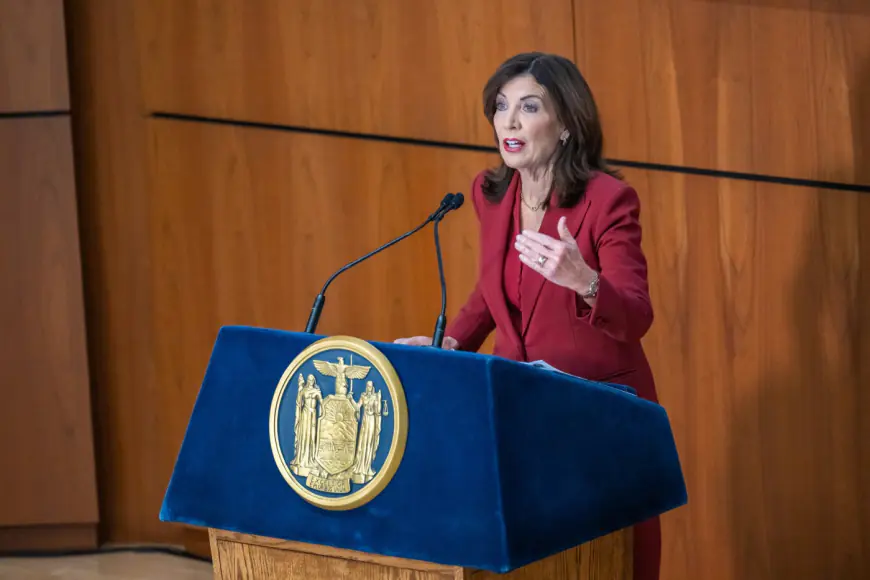Hochul must protect transit before it’s too late
This week's anniversary of Superstorm Sandy reminds us that New Yorkers need our leaders to protect us from a rapidly heating world. But, as much as extreme weather threatens our lives, homes, and infrastructure, political vendettas have their own unique destructive capacity.

This week’s anniversary of Superstorm Sandy reminds us that New Yorkers need our leaders to protect us from a rapidly heating world. But, as much as extreme weather threatens our lives, homes, and infrastructure, political vendettas have their own unique destructive capacity.
When Gov. Hochul stopped congestion pricing in June, she hurt millions of riders. Although nearly nine in 10 Manhattan-bound commuters ride public transit, she squandered more than $300 million in gridlock to date. It also, according to a brand new report by the Office of the State Comptroller — destabilized the MTA’s finances, taking it from “a path of financial stability to uncertainty.”
The governor’s actions also condemned us to slow ambulances and toxic air pollution for 1% of New Yorkers who will pay the toll — and get faster, more reliable commutes in exchange. She also canceled 100,000 New York jobs for a political gamble.
Donald Trump promised to end congestion pricing if reelected. As president, he delayed a new tunnel beneath the Hudson River to extort money for his wall and his administration stalled congestion pricing for years as it slowed the federal approval process to a crawl.
To no one’s surprise, his Project 2025 would eliminate federal transit funding altogether — no matter the consequences for millions of commuters in New York.
To protect New Yorkers and create the green, union jobs we all need to thrive, the governor must start congestion pricing now. The program must be up and running in advance of a potential new Trump administration that will train its vengeance on New York.
For months, Hochul has offered no plan to clean up the mess she made when she stopped congestion pricing and with it construction and manufacturing jobs across New York City, the suburbs and upstate.
With the looming threat of a second Trump administration, time’s up. The governor must strike an agreement with the federal government to secure the funding we need while she can still be sure she has a partner in the White House.
As this season’s storms demonstrated, the urgency of climate change is growing every day. Public transit is one of our most obvious pathways to cut carbon. Transit riders depend on congestion pricing for 23 station accessibility projects and an overhaul of train signals from the 1930s. We also need the funds to adapt our vulnerable infrastructure to rising tides, more rain, and stronger storms.
Hochul’s own Climate Resilience Roadmap for public transit, which she announced in April, is now on the line all due to her flip flop. Transformative projects to safeguard more than 200 subway stations that recently flooded and protect tracks along the Hudson in Westchester are part of the new MTA capital program adopted in September. Tens of thousands of good jobs ride on funding yet to be secured.
The reality is no matter what happens with the federal election, the state budget, or any other political or policy process, Hochul will have to make very difficult choices about how to rank New York’s urgent transit priorities.
She needs every last plausible dollar at her disposal. New Yorkers’ commutes, commuters’ families, and the livelihoods of the people who run the service, perform the maintenance, and make the upgrades and new equipment all rest on a transit system that works.
The whirling political storm of a Trump presidency would almost surely be joined by like minded majorities in Congress only more eager than the president to cut funding for transit, for riders, and to urban communities. It’s a zero-sum race to the bottom that we’ve seen before. The sequel will be much more painful and ruthless.
They would make it vastly harder for the governor to take the necessary steps to put thousands of people to work and protect millions of public transit riders from Atlantic storms like Sandy, much less deliver the reliable and accessible service we need and deserve from infrastructure that is in many cases much more than a century old.
Hochul can’t singlehandedly sway the election, nor change the weather. But luckily, she can put vast numbers of New Yorkers to work fixing our subway and protecting it for the future starting right now.
Our governor should act decisively and responsibly today and ensure that New York has as much money as possible to fund the transit system that every New Yorker, our city and households statewide depend on. She must do it.
Plum is executive director of the Riders Alliance. Moore is the executive director of climate and labor justice organization ALIGN and serves on the Riders Alliance board.
What's Your Reaction?









































































































